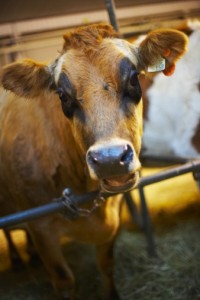Many people think that having a milk cow (or goat, as the case may be) is time consuming, shackling you to the farm day and night, night and day until your cow (or goat) has dried up. And then after she freshens, it’s back to the grindstone again.
be) is time consuming, shackling you to the farm day and night, night and day until your cow (or goat) has dried up. And then after she freshens, it’s back to the grindstone again.
But wait! There is a plan that allows you to be free as a bird whenever you want yet still be able to have a milk cow and all the goodies she gives you in return for feed, care and affection (whether she likes the affection or not).
I used this plan back in the old days when I was young and fancy-free, stronger and more able to handle four-legged beasts on my own, with no assistance from a husband (who was gone more often than not, at his job). However, he supported me in the plan and helped, when he was home at night and on weekends, with building fences, sheds, etc.
We started with a milk goat and her kid. When I wanted milk, I would lock the kid up at night in order to be able to take milk in the morning for my own use. When I did not want to milk, if I was going to be too busy to milk or gone on a trip, I would let the kid run with the goat twenty-four hours a day. The kid was anxious to be fed by momma, not by me, making it easier on me for feeding. And Momma was a happier camper than when she was separated from the kid for long amounts of time.
When we graded to a cow, the warnings came long and strong “ you’re going to be tied down! When will you have time of your own? Don’t ask ME to do the milking! But I was pretty sure that I could extend the length of the calf-on-momma scenario.
Now, we had a Brown Swiss/Jersey cross cow that had been pasture raised which meant she was NOT a friendly cow. She was fairly gentle, except when she had a calf. Then she was very protective. So it took speed and agility to get my tasks done when the calf was around. Ginger had the size and coloring of Brown Swiss with the heavy cream of the Jersey. She also had humongous amounts of milk that we shouldn’t waste on one calf.
For those of you who do not know the lifestyle of cows, it takes approximately a year of pregnancy for a cow to have that sweet little calf.
So when Ginger freshened (gave birth), we would go down to the neighboring dairy and purchase a day-old bull calf to foster on her. This took a little bit of doing. It also took a few years to realize that the foster had to be solid black. Ginger’s calves were always black; she could tell spotted from solid and would never accept that non-solid black calf. Now, for clarity’s sake, let’s give the calves names.
Ginger had bull calves every year except one. That year she gave us a heifer that I raised and sold as a great little milker. So we will have all boys names for her calf and her foster sons. Adam will be the name of her son and Bob will be the name for the foster.
And how did we know that we needed solid black calves? We once got a spotted calf and never DID get Ginger to foster him. We had to keep him separately from the other calf and lock Ginger up each time we needed to feed the spotted calf. Never again! Always solid black for us and for Ginger!
When Ginger came into the barn for her nightly feeding of grain, I would lock her into her stanchion and then drag Adam into the separating pen for the night. At that time, I would take Bob and put him on Ginger. She could tell it was a new calf and would kick, but I would hold her leg to stop her as the calf sucked.
Then both calves would spend the night in the separating pen and Ginger would spend the night outside in a shelter or grazing (depending on the weather).
When morning came, I would milk Ginger, generally taking only about a gallon of milk for use, then let both calves out while Ginger was still locked up. She couldn’t tell which calf was hers so she wouldn’t kick as much. After she was released to go outside, the calves would follow her. I would watch G inger for a while to see how she reacted to Bob. Normally she would bunt him away but not too strongly. It took about two days or so before Ginger could not tell the difference between calves and I didn’t have to worry about her harming Bob.
inger for a while to see how she reacted to Bob. Normally she would bunt him away but not too strongly. It took about two days or so before Ginger could not tell the difference between calves and I didn’t have to worry about her harming Bob.
So, after the fostering, it was easy “ lock Ginger up at night for her grain, grab the calves and put them in their pens (they got used to going in voluntarily) for the night. Then in the morning, milk Ginger, let her and the calves run during the day.
And, and, and! The best part? If I didn’t want to milk or wasn’t going to be home, the calves and Ginger ran together and I didn’t need to worry about milking.
Okay, so that worked well. However, calves are normally weaned at about three months. I can hear you saying Well, what about the rest of the year?
We would take Ginger’s original calf, Adam, to the stockyards and sell him. And would keep Bob for another use (hold that thought), but would make sure he was kept separate from Ginger at all times (a good fence is necessary here to keep the two separate). We then went back down to our neighboring dairy and purchased two new bull calves (black, of course) and fostered them onto Ginger.
Remember, Ginger, being a Brown Swiss and being fed well with good grass, good clean hay and grain twice a day, had plenty of milk. She was always watched for stress, which she never showed. So the two new calves (Charlie and Dan) were fostered in the same way Bob was; in a few days, Ginger had forgotten the bigger calves and had two new babies to love.
Therefore, same system held; lock the calves up at night if I wanted milk in the morning; let them run with Ginger if I didn’t want milk or didn’t have time to do the milking chores. As easy as baking an apple pie, but more fun!
Okay . Now came the end of six months – the new calves were now three months old. They went to the market to sell and I went back down to the dairy for one (only one, now) black bull calf – Edward. We fostered him onto Ginger and there we go, again! Same system. Why only one? Ah! It was well into Ginger’s pregnancy “ she was about six months along and it was time to give her a bit of a rest, so I didn’t want to put too much stress on her.
Nine months down the road, we sold Edward. That makes, if you have been counting, four calves purchased, four calves sold (at a profit, I might add). And Bob? He was then about nine months old and was kicking his heels up – he had forgotten that Ginger was his momma and could run along side her without trying to suck. He would run with her for about a year “ he’s a big part in the big plan.
Ginger, now, would have no calves for her last three months before freshening again. She had also dried up so we would have no milk (I’d frozen some for this time period) and was getting fat and sassy with her pregnancy. She still got her grain but not quite as much as when she was being milked and feeding calves.
Break time for all.
Now, you might ask, how did Ginger get bred? We had a small place and with only one cow, it was silly, expensive and even dangerous to have a bull running around all the time.
Ah ha! That’s in the plan, as well. We had started using Artificial Insemination on Ginger, but she was a difficult cow to get bred and after two times, the AI technician told us that we needed to go natural with her. So we hauled her down to the dairy and borrowed their bull. (A word about the dairy “ they had Holsteins but bred their cows to an Angus bull “ hence the predominance of black calves.)
It was difficult and inconvenient to haul her down every year “ I would have to go down to milk her during the time that she was visiting her man. So Bob (and his predecessors and his followers) became the man in the plan. Every year we would keep the first foster (Bob one, Bob two, Bob three, etc) and sell all the others. A bull calf is able to father calves when he’s about a year old or so. So Bob, being around a year or so old when Ginger was ready to be bred, would be Bob on the spot, so to speak. After we were sure Ginger was bred, then we would take Bob to the butcher and he would be our year’s supply of beef.
And so the cycle continued the entire time we had Ginger. The Bob of one year would be papa to the next year’s calf while the Bob of the current year would be kept for the next year. I had nine months of milking (or not), then three months of rest for me and for Ginger until she freshened again.
Now if you want to follow the plan, it does take planning but once it’s in place, there’s practically no thinking or planning at all. My husband would fuss at how much it took to keep a cow, but with this system, we made money. I had several customers that bought fresh milk and cream (I had them supply their own container, usually a gallon glass jar). I did not sell butter but made that for our own personal use, as well as keeping milk and cream for us. Yes, the calves cost money, assuredly, but selling them as three-month-old calves gave us a profit over what it cost to purchase them as day-old calves. So selling the calves paid for the grain and the hay needed in the winter and the next fosters to come. The money from the milk and cream was gravy, and the beef in the freezer was practically free.
You need to watch over your cow to make sure that you are not stressing her out, but if you know your cow, you will know how much you need to feed her and how many calves you can put on her at a time. The system of nine months with calves and three months of vacation will work great. And will give you freedom from daily milking.
































enjoyed your experiences with the cow……great way to deal with that aspect of the ‘Farm’. Thank you for sharing. Russ
I didn’t have a clue what I was doing when I went to a dairy and got my cow named Ella. I thought that I could milk her just as the article explains, but when I shared my idea with other people, I got only negative remarks. I am almost one year into milking Ella and things have gone very well. I replaced her biological calf – Bella (Holstein heifer) with a Brown Swiss heifer – Heidi, when Bella was about six months old. I missed Ella’s cycles after I tried to have her AI’ed and didn’t get her bred until I borrowed the neighbor’s Red Angus bull – Pretty Boy, during his off season. She should have a calf at the end of the summer.
I’ve been able to travel with the help of her calves. And Ella is a wonderful mother. She didn’t object to a new calf. She is a great milker and just so much fun to have around!
If you are looking to do the same and aren’t sure of things – just do it. If you love your animals, you will do the right thing for them. Let me know if you have any questions! I’d be happy to help! Ranee
Can you explain how you first milked this untrained cow? We have a miniature that we’ve been loving on since we got her and now it’s almost that time – – – I’d love to chat with you about this.
Thank you for this info – – – we’re FAR away from any breeder of dairy cows – Dusty
Dusty, why don’t you email me? cpthegreat@federatedwildblue.com and I’ll talk to you about training your cow.
Ranee, I’m glad you are having success with your Ella. It makes it easier to foster if momma is more willing. It’s nice that you can borrow a bull and have him come to YOU. Makes that easier, too.
Russ, that’s the way I feel. I have to enjoy the animals via reading and writing as we don’t have them any more (sigh). But they live on in my memories.
Oh my! This is a fantastic idea. We have had a milk cow for several years now & always end up having to take the calves off at about 6ymths as they are too big & rough. Then we end up milking twice a day. I had never thought of getting two fresh calves so thank you SO much – I will certainly be putting this into practice for the next time.
Andrex, I am so glad you are enjoying your cow. I so envy you youngsters that have them. I’m hoping to find someone near that I can buy raw milk from so that I can at least do things with milk, even without a cow.
I should add that in my experience, when a calf is on the cow she will hold back her cream! Since taking the calves off of Tulip she has given us so much cream we are making butter again. It also makes a difference on the breed of cow – when we had Jersey’s we did get some good cream even with a calf on but Tulip is a Dutch Belted Cross so her milk is naturally homogenized – yummy creamy milk but little on top when she has calves on her.